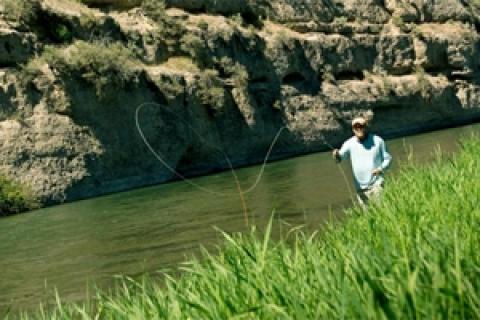
 It has happened to all of us as fly fisherman. We spot a big fish rising to the surface across the stream, inhaling a struggling insect drifting in the current. The excitement of seeing the trophy trout injects a shot of adrenaline into our bloodstream. Our heart jumps to our throat and pounds in our head. Confined quarters make us instantly realize that a roll cast is our only option. As we try to cast our fly into the feeding lane, our fly drifts off course and the leader wraps around an overhanging tree limb and the big fish darts for cover. Disappointed, we wonder what we did wrong.
It has happened to all of us as fly fisherman. We spot a big fish rising to the surface across the stream, inhaling a struggling insect drifting in the current. The excitement of seeing the trophy trout injects a shot of adrenaline into our bloodstream. Our heart jumps to our throat and pounds in our head. Confined quarters make us instantly realize that a roll cast is our only option. As we try to cast our fly into the feeding lane, our fly drifts off course and the leader wraps around an overhanging tree limb and the big fish darts for cover. Disappointed, we wonder what we did wrong.
I love small stream trout fishing and have repeated the above scenario many times and felt the rush of disappointment when it happens. Many anglers struggle with roll casting. I hope these tips help you improve your roll cast and begin to catch those big fish instead of spooking them.
#1 — Skate your fly smoothly across the surface to your anchor point. Staying in constant control of your fly line is key to a good roll cast. Make sure your fly stays on the water and moves steadily in a straight line all the way in to your anchor point. You grasp your fly line with your left hand and lift your rod straight up to accomplish this move. This action will help create a nice D-loop and will provide enough line to grab tension on the surface of the water to adequately load your rod and generate the necessary line speed needed during your roll cast.
#2 — Anchor your fly close to your left/right side. One of the most common mistakes anglers make when roll casting is not bringing their flies back close enough to their side before beginning the forward cast. Bringing the fly to the right position at your side is equally important in dominant side casting and an off-shoulder roll cast on your non-dominant side. By short stopping your fly, you will greatly reduce your accuracy and your D-loop will not be big enough to properly load your rod for the cast. Your presentation will be pushed significantly right/left if your anchor point is too far from your side when you begin your forward cast.
#3 — Stop your rod at your anchor point. The most common mistake fishermen make when roll casting is not bringing their rod to a complete stop when they reach their anchor point. The result is failure of the line to grab tension on the surface, resulting in inability to load the rod properly. The forward cast then fails.
#4 — Accelerate your rod tip smoothly without dropping your tip to the water. When roll casting, it's paramount to remember that you only have a forward cast to complete your cast. Since you don't have a back cast, make sure your forward cast has good form and efficiency. Concentrate on accelerating your rod in a straight path and stopping your rod abruptly at it's fastest point at the 2 o'clock position. This action will put maximum bend in your rod and provide the power needed to perfect a cast that straightens the leader and results in an accurate cast.
- 3295 views

